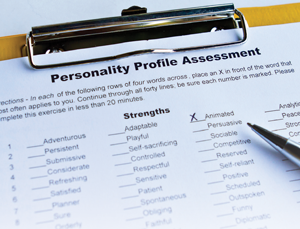The most successful teams are made up of a diverse, complement of people
Research shows we tend to like people who are like us. If we’re similar in style, our communication approaches are aligned and it makes it easy for us to understand one another. When we have differences in style and communication, rather than hearing the words another person uses, we react to their manner of speaking — tone, body language, facial expressions, etc.
Many a team has been fractured because of the differences in communication and work styles.
If you want to create a team that isn’t all the same — after all, the strength lies in the complement — it’s important to know who you have on your team and help the team members understand one another effectively. While there are many different tools to help individuals understand themselves and each other at a deeper level, a particularly useful method is the DiSC tool.
DiSC is a process created originally by William Moulton Marston, the inventor of the lie detector and the creator of the comic series “Wonder Woman,” more than 35 years ago. DiSC is a statistically validated tool that has been tested in more than 30 countries and passes the cultural test.
DiSC and the Four Ps
 DiSC shows there are four scales of behavior where we each have our personal preferences, on a scale of 0-100. If I’m left to approach any of the four Ps of behavior — Problems, People, Pace and Procedures — in a manner in which I’m most comfortable, I’ll have certain preferred approaches.
DiSC shows there are four scales of behavior where we each have our personal preferences, on a scale of 0-100. If I’m left to approach any of the four Ps of behavior — Problems, People, Pace and Procedures — in a manner in which I’m most comfortable, I’ll have certain preferred approaches.
If my preferred approach falls in a different place on the scale than yours, our styles and accompanying communication will come across differently.
D for Dominance, how we handle problems and challenges; I for Influencing, how we interact with people and derive our energy from interacting with others; S for steadiness, how we handle a steady pace and work environment; and C for Compliance (sometimes called Conscientiousness), how we handle rules and procedures set by others.
Each of the four scales (Dominance, Influencing, Steadiness and Compliance) has its own accompanying tone, body language and words we use. When people fall in different places on the chart, they can range from fast talkers moving quickly to a task and pushing through, to slow thinkers who get turned off by being pushed to make a decision. This is a simple example of how the differences cause conflict.
If as a leader you can learn more about how these work together, you’ll have more choice in developing your team and more ability to coach your team members to leverage the complement instead of having it be destructive.
Dominance
Some people are very strong on this scale. They’re the aggressive, assertive, “go get ’em” people who see a problem or challenge and want to conquer it. They move fast to task. Their emotion is anger, so these folks can come across as easily irritated or frustrated.
When one is high on this scale, they can be very intimidating to someone who is much lower.
Make sure the D on your team is tempered. Their drive is attractive, but the anger with which they can sometimes approach others is not.
Influencing
Some people high on this scale actually derive energy from being around others. They enjoy talking, questioning and interacting. They want to discuss ideas and talk about problems. They get motivated and engaged by their personal interactions. Their emotion is optimism, and they tend to be the cheerleader or supporter of the team.
Others are not as comfortable with lots of people interaction and actually get drained by too much. They don’t care to talk about everything and would prefer to be an interested observer and just listen. They can be perceived as disengaged.
Make sure you don’t punish a team member who is more quiet and reflective; they are taking in information about team dynamics you might need to know.
Steadiness
People high on this scale like structure. They like knowing the boundaries of the project or the role. They are process-oriented and like to have steps and know what comes next. They like to think about ideas and have time for considering. Their emotion is non-emotion, and they tend to be stoic. They don’t readily share feelings and emotional responses.
Others who are low S are the ball jugglers and wear their heart on their sleeves. If a team leader is low S with many higher S people working on the team, this can cause conflict. The higher S will do much better when the steps and process are clear.
Don’t have a “figure it out” person in charge of your high S team members if you want them to be most effective.
Compliance
The folks who score strongly here are the data people. They like to analyze and dig under the covers for details. They are high on quality control and want things to be correct and “right”. They are able to view a multi-page report and find the one typographical error on page 12. They enjoy following rules and believe the rules exist for a reason.
Their emotion is fear, because they are fearful of consequences if the rules are broken or the quality isn’t there. Their team members, the lower Cs, may be the rebels. They like to think about possibilities and what “could be.”
While they are thinking outside the box, their high C team members want everyone to get back in the box!
To have a successful team, you will do best to include all components. You don’t want all idea people, without implementers. You won’t do well with people all driving to success if no one is thinking about the best path to get there.
The differences do come between us. Using a tool like DiSC can be helpful to objectively show team members where they differ.
Most times, when we don’t understand another’s behavior, we label it and judge it negatively. DiSC can help people to see, more objectively, that we’re not all the same — and that can be good for the team.


 DiSC shows there are four scales of behavior where we each have our personal preferences, on a scale of 0-100. If I’m left to approach any of the four Ps of behavior — Problems, People, Pace and Procedures — in a manner in which I’m most comfortable, I’ll have certain preferred approaches.
DiSC shows there are four scales of behavior where we each have our personal preferences, on a scale of 0-100. If I’m left to approach any of the four Ps of behavior — Problems, People, Pace and Procedures — in a manner in which I’m most comfortable, I’ll have certain preferred approaches. 
